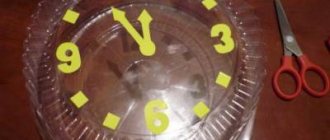Making something with your own hands is always nice. And if the thing turns out to be necessary and beautiful, such that it can be given as a gift, then this is absolutely good. You can make a clock from plywood, the drawings for which you can make yourself or find on the Internet. Such watches can be painted with paints, decoupaged on them, and pasted over with various objects - shells, beads, etc.
A plywood clock is a beautiful and necessary thing; it will decorate any home.
In addition, plywood is a very convenient material to work with because it is easy to process, so you can use it to realize any ideas.
DIY wooden clock drawings. Pendulum clock deer
The idea of creating a watch out of wood hung in my head for a very long time, it was ripening, so to speak. At that time I was working at a wood processing plant, it would have been a sin not to take advantage of the opportunity to do something for myself. So, after scouring the web, I found several sites where they offered to buy ready-made drawings/models. On one of the sites, drawings in PDF format were available. It was possible to buy it, but it was interesting to rebuild it yourself and, if necessary, make changes to the drawings. The website itself: https://www.woodenclocks.co.uk/index.htm
Appearance:
Assembly diagram:
Scheme of operation of the anchor mechanism:
Model built in PowerShape: breakdown by workpiece:
Assembly:
Naturally, I wrote the entire treatment myself. The processing was written in PowerMILL. Processing the dial and small details.
Writing processing for gears.
He made watches from walnut and oak. The frame, dial, hands, and some small details are made of walnut. Walnut was used with a thickness of 16mm. All gears are made of oak. The so-called “deck” blank is a 3mm thick veneer glued together under a press and calibrated to a size of 8mm. Made from re-glued material, because... I thought that the plywood would be more durable and less susceptible to warping. I bought axles in a store, 6, 8 and 10 mm thick, made of beech. The factory does not have the equipment to produce such small items).
All processing was carried out on a FlexiCAM machine. This is not a small machine; in the photo, a sheet of plywood 2.5 * 1.5 meters is processed. There are other completely different details in the photo, perhaps more about them another time. I also did the processing on the machine myself and did not trust it to the operator. But somehow my hands were full and there was no camera at hand, so there is no photo of the actual processing on the machine ((.
Workpieces after the machine:
Sanded Gears
First build
And this is a small assistant. Grabbed the frame halves and let's run with them. Shouts - I'm a tractor! After that I had to glue one of the halves. Fortunately, wood is a good material, you can’t even find where it was glued after gluing it.
Dry assembly
Side view. This version does not yet have a single metal part. When I first read the author’s website, he mentioned that you shouldn’t make axles out of wood, there will be problems with them, but then I somehow missed it.
Tiny seconds hand
All parts were covered with teak oil. Oil does not change the texture of the material, but highlights it and makes the color more saturated. Well, the details become a little matte. I like oil better than varnish.
Blocks for hanging loads. If the weight is attached directly to the clock, then the winding will last for 12 hours. But this is not enough and the table under the clock interfered with this design. I let the rope go to the ceiling and to the corner where the load would not bother anyone. I used a chain hoist). As a result, the plant lasts for a couple of days. When the load is near the floor, the little one likes to kick it and tug at it))). I scold you.
The material is striped - I took scraps from blanks at the factory. This material, made from walnut and maple plywood, is called laminate. Butts are made from it, and they turn out very beautiful. But this is kind of exclusive. Usually it is walnut for oiling or beech for painting.
After covering it with oil, it turned out that the watch did not want to run. The sanded ones just walked without problems, and then they started to stop. I had to grind all the axes into the holes and lubricate them with graphite. In general, on the next watch I will install bearings everywhere, well, well... such problems.
The anchor is closer. While I was adjusting, I got carried away and cut off the excess. I had to glue a little meat onto one of the teeth of the anchor.
Escape wheel In general, a watch is a thing that requires precision and care in manufacturing. If you haven’t cleaned a tooth somewhere or left a burr, they will stop.
Final assembly Changes regarding the plant mechanism had to be made to the author's design. Brian suggested making the plant with a key. Initially, I did just that, but after a month of use I realized that if I don’t change it, the clock will eventually stop working. Imagine, to start it for a day you need to make 24 revolutions of the wheel on which the thread is wound. 24 revolutions are 48 half-turn hand movements. Taking into account the fact that the watch is hung high, the hand simply gets tired. I changed it so that when you pull the black cord, the watch starts. Fast and easy.
Preparing the location for wall mounting
Wall installation. The wall turned out to be uneven; the upper attachment point had to be moved a few millimeters from the wall, otherwise the pendulum would touch the bottom of the wall.
Installing blocks, passing the cord through the blocks
Preparation for cargo. So far the pipe is dirty and there isn't enough lead inside to finish it. In general, a load of one and a half kilograms is enough to operate the watch. I plan to hang the load on a triple chain hoist so that the plant will last for three days, so the load will need to be about 4 kg. The pipe will need to be shortened a little, but not by much. As a result, the length will be somewhere around 330 mm.
Well, what happened in the end, a few photos.
Many people think that wooden watches are not accurate watches. No, that's not true. This is a mechanism, everything is tied to the movement of the pendulum, and therefore to the force of gravity. I stopped adjusting them when the accuracy became about 30 seconds per day. I did not build a threaded metal rod into the pendulum, and the weight simply moves along the wood with tension. If you integrate a threaded rod, you can adjust it to precision in seconds. The goal in production was to make a beautiful and useful thing, and not to make a chronometer))).
What was unexpected is that the watch is quite loud. Those. they hang in the kitchen and at night you can hear them in the room)). This is the reason why they hang in the kitchen. Jaune cursed. She didn't like them at all. But I like them. And I like the way they tick. They create comfort with their measured pace.
The video can be viewed on the page in my world.
The idea of creating a watch out of wood hung in my head for a very long time, it was ripening, so to speak. At that time I was working at a wood processing plant, it would have been a sin not to take advantage of the opportunity to do something for myself. So, after scouring the web, I found several sites where they offered to buy ready-made drawings/models. On one of the sites, drawings in PDF format were available. It was possible to buy it, but it was interesting to rebuild it yourself and, if necessary, make changes to the drawings. The website itself: https://www.woodenclocks.co.uk/index.htm
Appearance:
Assembly diagram:
Scheme of operation of the anchor mechanism:
Model built in PowerShape: breakdown by workpiece:
Assembly:
Naturally, I wrote the entire treatment myself. The processing was written in PowerMILL. Processing the dial and small details.
Writing processing for gears.
He made watches from walnut and oak. The frame, dial, hands, and some small details are made of walnut. Walnut was used with a thickness of 16mm. All gears are made of oak. The so-called “deck” blank is a 3mm thick veneer glued together under a press and calibrated to a size of 8mm. Made from re-glued material, because... I thought that the plywood would be more durable and less susceptible to warping. I bought axles in a store, 6, 8 and 10 mm thick, made of beech. The factory does not have the equipment to produce such small items).
All processing was carried out on a FlexiCAM machine. This is not a small machine; in the photo, a sheet of plywood 2.5 * 1.5 meters is processed. There are other completely different details in the photo, perhaps more about them another time. I also did the processing on the machine myself and did not trust it to the operator. But somehow my hands were full and there was no camera at hand, so there is no photo of the actual processing on the machine ((.
Workpieces after the machine:
Sanded Gears
First build
And this is a small assistant. Grabbed the frame halves and let's run with them. Shouts - I'm a tractor! After that I had to glue one of the halves. Fortunately, wood is a good material, you can’t even find where it was glued after gluing it.
Dry assembly
Side view. This version does not yet have a single metal part. When I first read the author’s website, he mentioned that you shouldn’t make axles out of wood, there will be problems with them, but then I somehow missed it.
Tiny seconds hand
All parts were covered with teak oil. Oil does not change the texture of the material, but highlights it and makes the color more saturated. Well, the details become a little matte. I like oil better than varnish.
Blocks for hanging loads. If the weight is attached directly to the clock, then the winding will last for 12 hours. But this is not enough and the table under the clock interfered with this design. I let the rope go to the ceiling and to the corner where the load would not bother anyone. I used a chain hoist). As a result, the plant lasts for a couple of days. When the load is near the floor, the little one likes to kick it and tug at it))). I scold you.
The material is striped - I took scraps from blanks at the factory. This material, made from walnut and maple plywood, is called laminate. Butts are made from it, and they turn out very beautiful. But this is kind of exclusive. Usually it is walnut for oiling or beech for painting.
After covering it with oil, it turned out that the watch did not want to run. The sanded ones just walked without problems, and then they started to stop. I had to grind all the axes into the holes and lubricate them with graphite. In general, on the next watch I will install bearings everywhere, well, well... such problems.
The anchor is closer. While I was adjusting, I got carried away and cut off the excess. I had to glue a little meat onto one of the teeth of the anchor.
Escape wheel In general, a watch is a thing that requires precision and care in manufacturing. If you haven’t cleaned a tooth somewhere or left a burr, they will stop.
Final assembly Changes regarding the plant mechanism had to be made to the author's design. Brian suggested making the plant with a key. Initially, I did just that, but after a month of use I realized that if I don’t change it, the clock will eventually stop working. Imagine, to start it for a day you need to make 24 revolutions of the wheel on which the thread is wound. 24 revolutions are 48 half-turn hand movements. Taking into account the fact that the watch is hung high, the hand simply gets tired. I changed it so that when you pull the black cord, the watch starts. Fast and easy.
Preparing the location for wall mounting
Wall installation. The wall turned out to be uneven; the upper attachment point had to be moved a few millimeters from the wall, otherwise the pendulum would touch the bottom of the wall.
Installing blocks, passing the cord through the blocks
Preparation for cargo. So far the pipe is dirty and there isn't enough lead inside to finish it. In general, a load of one and a half kilograms is enough to operate the watch. I plan to hang the load on a triple chain hoist so that the plant will last for three days, so the load will need to be about 4 kg. The pipe will need to be shortened a little, but not by much. As a result, the length will be somewhere around 330 mm.
Well, what happened in the end, a few photos.
Many people think that wooden watches are not accurate watches. No, that's not true. This is a mechanism, everything is tied to the movement of the pendulum, and therefore to the force of gravity. I stopped adjusting them when the accuracy became about 30 seconds per day. I did not build a threaded metal rod into the pendulum, and the weight simply moves along the wood with tension. If you integrate a threaded rod, you can adjust it to precision in seconds. The goal in production was to make a beautiful and useful thing, and not to make a chronometer))).
What was unexpected is that the watch is quite loud. Those. they hang in the kitchen and at night you can hear them in the room)). This is the reason why they hang in the kitchen. Jaune cursed. She didn't like them at all. But I like them. And I like the way they tick. They create comfort with their measured pace.
The video can be viewed on the page in my world.
This unsightly looking mechanical wall clock
have one significant advantage over conventional watches: they have a power reserve of up to
four days
, whereas, like a regular watch, the power reserve is 1-2 days.
A large power reserve was the main task in the development of these watches, in solving which it was necessary to simultaneously provide technology for mass production, and ensure minimal friction losses in the gears, and not particularly overload the weight. The result is a product that we present to your consideration. call it a prefabricated watch model
, because...
This is no longer a model, but a full-fledged working mechanism. The working wooden watch mechanism
is assembled from laser-cut gears included in the kit, which are mounted on wooden axles and
bearings
.
The clock mechanism of these bearings uses as many as 8 pieces, and the ninth is in the weight, which ensures easy and reliable movement. This wooden watch
uses a Graham escapement, weight drive and wheel winding.
And although the clock uses about 150 parts (of which about one and a half dozen gears), to assemble this wooden clock you only need glue (such as PVA and cyanoacrylate), a sharp knife and a file. The design turned out to be interesting! The clock mechanism is open, without a case
.
And the dial and hands are made in contrasting black and white, in contrast to the brown color of the mechanism itself. The clock is driven by a hanging weight, into which you will need to fill 1.5 or 3 kg of weight (we recommend using 8 or 8.5 mm lead buckshot as a filler). The design of the watch is designed for two options for using the weight: full-fledged mode, when one winding of the weight lasts for four days
, and light mode, when the weight of the weight can be reduced, but the watch will have to be wound once every two days.
As with all mechanical watches
of this design, the accuracy of the movement is regulated by the position of the pendulum lens.
A well-tuned watch will provide you with an accuracy of 1-2 minutes per day. To increase the durability of wooden watches,
it is advisable to coat their parts with two or three layers
of Danish oil
. Additionally, the oil will give your wall clock a nice, professional look.
About us We promise that:
- Having more than 15 years of experience, we offer only the best products on the market, eliminating obvious failed products;
- We deliver goods to our customers all over the world accurately and quickly.
Customer Service Rules
We are happy to answer any relevant questions that you have or may have. Please contact us and we will do our best to respond to you as soon as possible. Our field of activity: prefabricated wooden models of sailing ships and other ships, models for assembling steam locomotives, trams and carriages, 3D models made of metal, prefabricated mechanical watches made of wood, construction models of buildings, castles and churches made of wood, metal and ceramics, hand and power tools for modeling, consumables (blades, nozzles, sanding accessories), glues, varnishes, oils, wood stains. Sheet metal and plastic, tubes, metal and plastic profiles for independent modeling and making mock-ups, books and magazines on woodworking and sailing, ship drawings. Thousands of elements for independent construction of models, hundreds of types and standard sizes of slats, sheets and dies of valuable wood species.
- Worldwide delivery. (except some countries);
- Fast processing of received orders;
- The photographs presented on our website were taken by us or provided by the manufacturers. But in some cases, the manufacturer may change the packaging of the product. In this case, the photographs presented will be for reference only;
- Delivery times provided are provided by carriers and do not include weekends or holidays. At peak times (before the New Year), delivery times may be increased.
- If you have not received your paid order within 30 days (60 days for international orders) from dispatch, please contact us. We will track the order and contact you as soon as possible. Our goal is customer satisfaction!
Our advantages
- All goods are in our warehouse in adequate quantities;
- We have the most experience in the country in the field of wooden sailboat models and therefore can always objectively assess your capabilities and advise what to choose to suit your needs;
- We offer you various delivery methods: courier, regular and EMS mail, SDEK, Boxberry and Business Lines. These carriers can completely cover your needs in terms of delivery time, cost and geography.
We firmly believe that we will become your best partner!
Try cutting out a craft like this. Your loved ones will certainly like it by placing it in a visible place, for example, on a shelf. To make this craft you will need the following:
Sawing tools.
General information
Where did grandfather clocks come from?
The term floor clock “Floor clock” came to our country from England, and its varieties appeared there:
- — “Grandfather Clock” or grandfather clock, height 195-200 cm;
- — “Grandmother Clock” or grandmother’s clock, height 150-190 cm;
- — “Granddaughter Clock” or granddaughter’s clock, height does not exceed 150 cm.
They first appeared in the 17th century; in those days, this piece of furniture was an indicator of wealth and testified to the aristocratic origin of their owners.
At first, the clock looked like a narrow cabinet in which the clock mechanism was located, and on the outside there was a dial. And only almost a hundred years later, the production of watches with a glass front began; now, in addition to the dial, an exquisite pendulum was presented to the eye.
Types of grandfather clocks:
- Classic vintage ones are made of dark wood or veneer. Outwardly they resemble the Big Ben tower.
- Interior clocks can be made of either wood or plywood. The shape and color depend on the design decision.
- Modern clocks can be very different, for example, in the form of a street lamp or a telephone booth. Materials for production: glass, metal, plastic, wood.
Preparing your desktop
First of all, you need to prepare your table on which you will work. There should be no unnecessary things on it and every tool should be at hand. Not everyone has their own desktop and has probably already thought about creating one. Making a table is not difficult, but choosing a place for it in the house is difficult. The ideal option is an insulated balcony, on which you can do crafts at any time. I have already written about preparing the table in a separate article and tried to describe in as much detail as possible the entire process of creating it. If you don’t know how to prepare your workplace, then read the following Article. After you have completed the process of creating a table, try to start choosing your future craft.
Another option for plywood clocks
The second option is similar to the first, however, there are also differences.
For it you will need:
- Drill with saw.
- Scissors with a soft sponge.
- Zero sheet.
- Pencil with ruler.
- Iron with hairdryer.
- Working clock mechanism and sheet of plywood.
- Acrylic varnish and hairspray.
- PVA glue with water.
- And acrylic primer with paints.
When the shape and dimensions of the product are determined, the clock is first drawn, then cut out, for example, sawed out with a jigsaw, and cleaned.
Just as in the first case, the center for attaching the mechanism is outlined with a pencil and after that you need to draw two identical lines intersecting each other in the center.
Next, the hole is drilled, cleaned and, if necessary, bored. This is necessary so that the fasteners can pass freely and without pressure. The carpentry work ends here and then the workpiece is primed.
It is necessary to prime with acrylic primer exactly twice. The second layer is applied no earlier than the first has dried; it usually dries within an hour.
After this, the workpiece is taken, smeared with diluted PVA glue, and thoroughly dried with a hairdryer. When the glue has dried, a colored napkin is smeared in the same way, pressed tightly to the workpiece and ironed. Next, numbers are cut out of paper, which, after coloring, are glued to a napkin.
The last and most important stage is assembling the clock mechanism. It is very easy to assemble. You just need to remember how everything works when disassembling. After the mechanism is installed and running, all that remains is to hang the clock in the most visible place.
We choose quality material
The main material is plywood. The choice is always difficult. Each of us has probably encountered such a problem as delamination of plywood from the end part and asked the question, what causes this delamination? Well, of course, this is mainly due to low-quality plywood. If this is not the first time you have picked up a jigsaw, then you can select plywood from the remnants of a previous craft. If you are new to sawing and you don’t have plywood, then buy it at a hardware store. Choosing material for sawing is always difficult. You should always choose plywood carefully, often look at the defects of the wood (knots, cracks) and draw conclusions. The difficulty in choosing plywood lies in the fact that no matter how you guess at its defects and shelf life. For example, you bought plywood, cleaned it, translated the drawing and suddenly it began to delaminate. Of course, this has happened to almost everyone and it’s oh, how unpleasant. So it is better to pay attention when choosing and choose good plywood. I wrote a special Article in which all the principles of choosing plywood are described step by step.
Decoration methods
Before making a watch with your own hands, it is useful to study possible techniques for decorating it. The following basic methods of decorative finishing are distinguished:
- Decoupage. It involves attaching a picture or ornament to the surface of an object and then coating the resulting composition with varnish.
- Quilling. The art of paper rolling, which is based on the production of 2D or 3D drawings from paper twisted into spirals, cut into long, narrow strips.
- Scrapbooking. The method involves using family photographs and children's drawings to create collages.
- Embroidery. A variety of techniques can be used.
- Painting with acrylic based paints. Can be produced in any style.
- Use of wood blanks.
- Using stamps to imprint a pattern.
- Working with epoxy. The method consists of filling the mold with resin with the addition of various decor (sparkles, beads, dried flower heads).
You should decide which decorative design option is closer to you - maybe you have already mastered something. On the other hand, creating watches is a good reason to try to learn a new style.
Stripping plywood
We clean our plywood with sandpaper. As you already know, “Medium-grained” and “Fine-grained” sandpaper is used for cleaning plywood when sawing. You've probably seen sandpaper in hardware stores, and that's what we'll need. In your work you will need “Coarse-grained”, “Medium-grained” and “Fine-grained” sandpaper. Each of them has its own property, but a completely different coating, by which it is classified. “Coarse-grained” sandpaper is used for processing rough plywood, i.e. which has many defects, chips, and cracks. “Medium-grained” sandpaper is used for processing plywood after “Coarse” sandpaper and has a slight coating. “Fine-grained” or otherwise “Nulevka”. This sandpaper serves as the final process for stripping plywood. It gives the plywood smoothness, and therefore the plywood will be pleasant to the touch. Sand the prepared plywood in stages, starting with medium-grain sandpaper and ending with fine sandpaper. Sanding should be done along the layers, not across. A well-polished surface should be flat, completely smooth, glossy in the light and silky to the touch. How best to prepare plywood for sawing and which sandpaper is best to choose Read here. After stripping, check the plywood for burrs and small irregularities. If there are no visible defects, then you can proceed to the process of translating the drawing.
Translation of the drawing
For me, drawing translation has always been the main process in my work. I will tell you a couple of rules, as well as tips for high-quality translation of a drawing. Many people transfer the drawing onto plywood not only using a pencil and copying, but also using “Black Tape”, glue the drawing to the plywood, then wash off the drawing with water and the markings of the drawing remain on the plywood. In general, there are many ways, but I will tell you about the most common method. To transfer the drawing onto prepared plywood, you must use a copy, a ruler, a sharp pencil and a non-writing pen. Fasten the drawing in plywood using buttons or simply hold it with your left hand. Check if the drawing fits the dimensions. Arrange the clock drawing so that you can use a sheet of plywood as economically as possible. Translate the drawing using a non-writing pen and ruler. There is no need to rush, because your future craft depends on the drawing.
Master class No. 4. Clocks from old magazines or newspapers
Magazines and newspapers can also be used to make original wall clocks.
Wall clock from old magazines
In this case, you need to prepare:
- hands, clock mechanism;
- pages of magazines or newspapers (24 pieces, approximately the same size);
- a circle cut out of cardboard with a hole in the center;
- pencil or pen;
- transparent plastic discs (2 pcs., you can take them from CD boxes);
- scissors;
- silk thread for embroidery;
- long needle;
- transparent tape.
Materials and tools for making watches
Step 1: Start by wrapping the first page around a pen or pencil. Make all 24 tubes in the same way, secure their ends with adhesive tape so that they do not unwind. Next, step back from the edge of the tube by about 1/3 and bend it in half in this place.
Popular articles If you don’t know how to cheat on an exam, look!
The page is wrapped around the handle, the finished tube is bent
Step 2: Thread a long needle and thread it through the bent end of the tube. Pull the needle through and tie a knot at the end of the thread; Sew all the tubes in a circle in the same way.
The thread is pulled through the bent ends
The tubes are arranged in a circle
Step 3. Place a transparent disk on top of the tubes so that the hole on it is located in the center of the resulting circle. Place the clock mechanism on the disk so that the fasteners for the hands align with the hole.
Clock mechanism included
Step 4. Then turn the structure over and attach another disk. Place cardboard on top and secure the clock mechanism with a nut.
The mechanism is secured with a nut
Step 5. Then screw the arrows themselves. Homemade wall clock is ready!
Screw the clock hands and you're done
Drilling holes in the parts
As you have already noticed, the parts contain parts of the grooves that need to be cut out from the inside. To cut out such parts, you need to drill holes in them using a hand drill or, as in the old fashioned way, make holes with an awl. By the way, the diameter of the hole must be at least 1 mm, otherwise you can damage the elements of the drawing, which, alas, are sometimes difficult to restore. To avoid damaging your work table when drilling holes, you must place a board under the workpiece so as not to damage the work table. It is always difficult to drill holes alone, so ask a friend to help you in your task.
Sawing parts
There are many rules for cutting, but you need to stick to the most common ones. First of all, you need to cut out the internal parts, only then according to the external pattern. There is no need to rush when cutting. The main thing is to always keep the jigsaw straight at a 90-degree angle when cutting. Cut out the parts along the lines you accurately marked. The movements of the jigsaw should always be smooth up and down. Also, do not forget to monitor your posture. Try to avoid bevels and unevenness. If you go off the line while cutting, don't worry. Such bevels and irregularities can be removed using flat files or “coarse-grained” sandpaper.
Cleaning Parts
You should always clean the parts of a future craft carefully. At the very beginning of the work, you already sanded the plywood with sandpaper. Now you have to do a small part of stripping the plywood. Using medium-grain sandpaper, sand the edges of the parts and the back of the plywood. “Fine-grained” sandpaper is considered the final stage of cleaning parts. It is better to clean the front part of the parts with fine sandpaper. When processing plywood, take your time. You can also use a rounded file, which is convenient for cleaning the inside of the holes. Try to ensure that the parts come out without burrs or irregularities.











